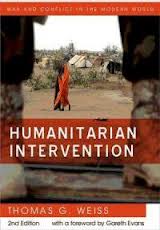|
Reviewed by David M. Claborn, Assistant Professor, Public Health and Homeland Security, Missouri State University Countries that cannot or will not protect their citizens from extreme want and violence are obligated to request assistance from the international community; the country in need that refuses to ask for and receive such aid temporarily forfeits its sovereignty and is subject to involuntary intervention. That intervention may be military and can occur against the will of the country, but it must have humanitarian justification. This controversial contention is the thesis of Thomas Weiss’s book “Humanitarian Intervention.” Weiss is an advocate of the R2P or “responsibility to protect” concept that states a sovereign government’s primary responsibility is to protect persons and property. France’s recent incursion in the sovereign state of Mali provides good reason to revisit this concept as described in Weiss’s 2007 book. The concept of conditional sovereignty is disturbing to many who are used to the laws of international conduct that usually emphasize non-intervention, domestic jurisdiction, impartiality, non-use of force, and the near-sanctity of state sovereignty. Weiss contends, however, that the world has changed since the end of the Cold War, losing its inhibitions established in a polarized atmosphere and releasing forces of greed, tribalism, crime and unbridled violence. The result is a group of relatively weak countries with populations subject to ethnic cleansing, genocide and crimes against humanity. Weiss contends that the international community is obligated, at least in some of these situations, to intervene for humanitarian reasons. As examples of recent humanitarian interventions, successful and not, he describes the efforts in Somalia, northern Iraq (1991), Haiti, Kosovo, and pre-Dayton Bosnia. Weiss notes that the civil wars of the 1990s “challenge the traditional principles of humanitarians” including neutrality. (p. 73) This challenge reflects the increasing number of deaths in aid workers and acknowledges the fact that aid in the absence of military protection may not only be futile, but dangerous. The concept of humanitarian intervention appears to have been supported by United Nations officials, including Kofi Annan who reportedly has said that the sovereignty of individuals outweighs the sovereignty of the state. Boutros Boutros-Ghali is also quoted as having said “the time of absolute state sovereignty … has passed.” (p. 18). Weiss is cognizant of the controversy associated with this view of conditional sovereignty, particularly as it relates to humanitarian agencies and developing world countries with a colonial past. This latter group is of particular interest in the current Mali situation. Sending troops to protect an abused population or to pre-empt even greater violence may seem to fulfill an obvious moral obligation in Paris or Washington, but in former colonies it may appear as a return to imperialism and colonialism. In the Moslem world, it may seem as yet another incursion of Crusaders into an Islamic land. Humanitarian workers have long known that any affiliation with the military can result in distrust by some locals who are the target of the humanitarian aid. Nevertheless, Weiss notes several conditions that demand the security only a military force can provide. For those concerned about rampant U.N. intervention in the internal affairs of numerous countries, it may be comforting to note that Weiss sets very strict guidelines for the use of humanitarian intervention. The threshold for intervention should be “acts of such magnitude that they shock the conscience and illicit a fundamental humanitarian impulse.” (p. 104). Even this description, however, seems vague and open to varying interpretations. Much of the world is horrified by governments that prevent girls from obtaining educations or amputate the limbs of criminals. Do these justify humanitarian intervention? Fortunately, Weiss provides a more quantifiable basis for intervention in the form of mass internal displacement of populations. Public health workers have known for years that displaced populations are a key factor in epidemics and massive suffering.1 Although this variable may help to establish a threshold for intervention, it seems insufficient as a universal rule. Weiss is both realistic and practical. He acknowledges that powerful countries can also tolerate or even cause great suffering for their own populations, but that intervening in such a situation would cause even greater suffering. After all, as he notes, one can question the wisdom of an involuntary intervention in a country that possesses nuclear weapons. Weiss recognizes two groups of nations: one group of weak nations that is subject to international intervention and another group of powerful nations that is not. This inconsistent application of the concept, though realistic, may be one of the more difficult aspects of humanitarian intervention for the world to accept, especially the developing world. “Humanitarian intervention” is an accessible but too concise accounting of a controversial perspective on the field of humanitarian aid. It reflects a growing realization that, in many situations, effective security is essential to any successful efforts to reduce human suffering and death. At the same time, the book demonstrates the situational inconsistencies inherent to such efforts, and the danger that populations from the developing world will see interventions as a return to colonialism. The book would benefit from more complete description and analysis of some of the successful and unsuccessful interventions. Nevertheless, the book provides an excellent introduction to the concept of humanitarian interventions and would be a valuable addition to the library of those working with non-governmental aid organizations, military security and peace-keeping forces, and state departments throughout the world. 1 See JT Watson et al., “Epidemics after natural disasters,” Emerging Infectious Disease 13(1): 2007. |


 Humanitarian Intervention
Humanitarian Intervention 